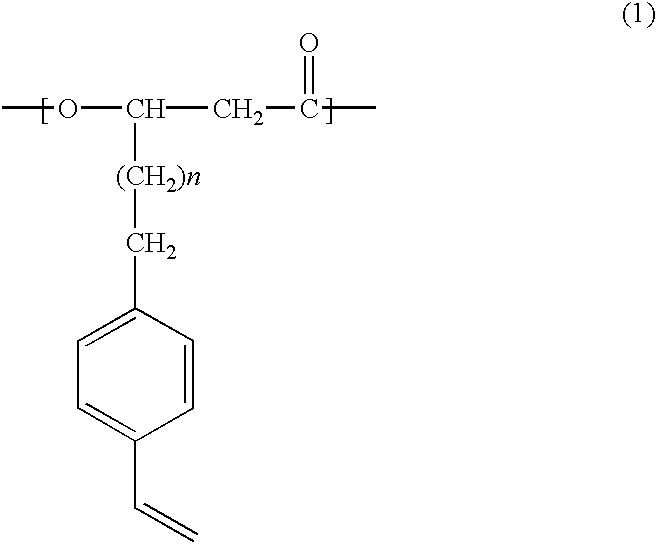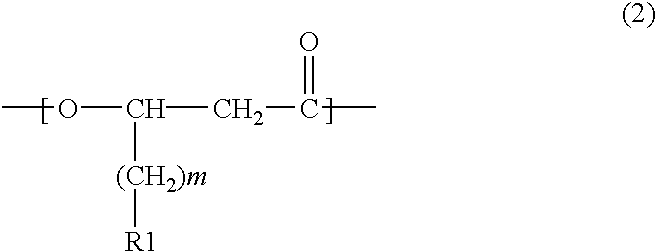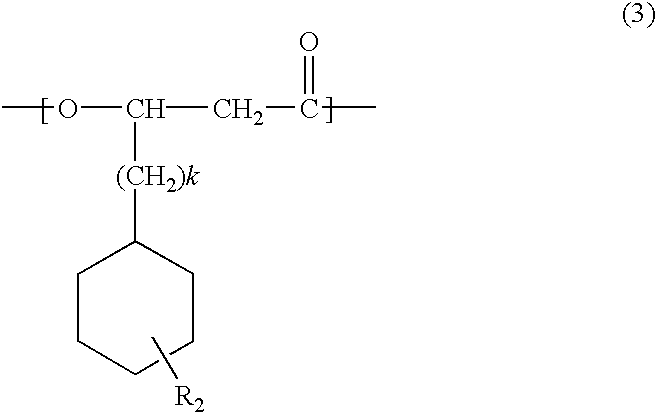Novel polyhydroxyalkanoate copolymer containing in molecule unit with vinylphenyl structure in its side chain and method of manufacturing the same
a polyhydroxyalkanoate and copolymer technology, applied in the field of polyhydroxyalkanoate copolymer, can solve the problems of insufficient decomposition and solubility of insoluble components, affecting the quality of insoluble components, and reducing the number of existing materials having excellent desired characteristics, etc., to achieve good processability, high glass-transition temperature, and high melting point
- Summary
- Abstract
- Description
- Claims
- Application Information
AI Technical Summary
Benefits of technology
Problems solved by technology
Method used
Image
Examples
example 2
A culture medium, which contains 5-(4-vinylphenyl)-valeric acid provided as .omega.-(4-vinylphenyl)-alkanoic acid represented by the general formula (16), 5-phenyl-valeric acid provided as .omega.-substituted alkanoic acid represented by the general formula (17), and further, polypeptone provided as peptides, was prepared by the following procedures. 1.0 g of polypeptone (commercially available from Wako Pure Chemical Industries, Ltd.) and 0.19 g of 5-phenyl-valeric acid were dissolved in 200 ml of the M9 culture medium and the resultant solution was then charged into a shaking flask (500 ml volume), followed by autoclave sterilization. After the heat sterilization, the flask was cooled to room temperature. Furthermore, 0.20 g of 5-(4-vinylphenyl)-valeric acid was added to the flask and the mixture was stirred well. Consequently, a culture medium was prepared.
Previously, a 0.5% polypeptone-containing M9 culture medium was inoculated with a Pseudomonas cichorii YN2 and was then shake...
example 3
In this example, the production of polymer was performed by the same steps under the same conditions as those of Example 1, except that the strain P161 was used as the microorganism instead of the YN2 strain used in Example 1.
The structure of the collected polymer was determined by .sup.1 H-NMR measurement just as in the case with Example 1. The collected polymer was found to be a polyhydroxyalkanoate copolymer containing three units represented by the following formula (23) at a content ratio of A:B:C=2:78:20 (% by mole). ##STR38##
In addition, the average molecular weight of the polymer was measured by the method using the gel permeation chromatography described in Example 1.
In Table 3, the dry weight of the microbial cells obtained through the above-mentioned steps, the dry weight of the collected polymer, the weight ratio of the collected polymer per dried microbial cell, and the number average molecular weight, the weight average molecular weight, and the molecular weight distri...
example 4
In this example, the production of polymer was performed by the same steps under the same conditions as those of Example 1, except that the H45 strain was used as the microorganism instead of the YN2 strain used in Example 1.
The structure of the collected polymer was determined by .sup.1 H-NMR measurement just as in the case with Example 1. The collected polymer was found to be a polyhydroxyalkanoate copolymer containing three units represented by the following formula (24) at a content ratio of A:B:C=1:82:17 (% by mole). ##STR39##
In addition, the average molecular weight of the polymer was measured by the method using the gel permeation chromatography described in Example 1.
In Table 4, the dry weight of the microbial cells obtained through the above-mentioned steps, the dry weight of the collected polymer, the weight ratio of the collected polymer per dried microbial cell, and the number average molecular weight, the weight average molecular weight, and the molecular weight distrib...
PUM
| Property | Measurement | Unit |
|---|---|---|
| Fraction | aaaaa | aaaaa |
| Fraction | aaaaa | aaaaa |
| Fraction | aaaaa | aaaaa |
Abstract
Description
Claims
Application Information
 Login to View More
Login to View More - R&D
- Intellectual Property
- Life Sciences
- Materials
- Tech Scout
- Unparalleled Data Quality
- Higher Quality Content
- 60% Fewer Hallucinations
Browse by: Latest US Patents, China's latest patents, Technical Efficacy Thesaurus, Application Domain, Technology Topic, Popular Technical Reports.
© 2025 PatSnap. All rights reserved.Legal|Privacy policy|Modern Slavery Act Transparency Statement|Sitemap|About US| Contact US: help@patsnap.com



